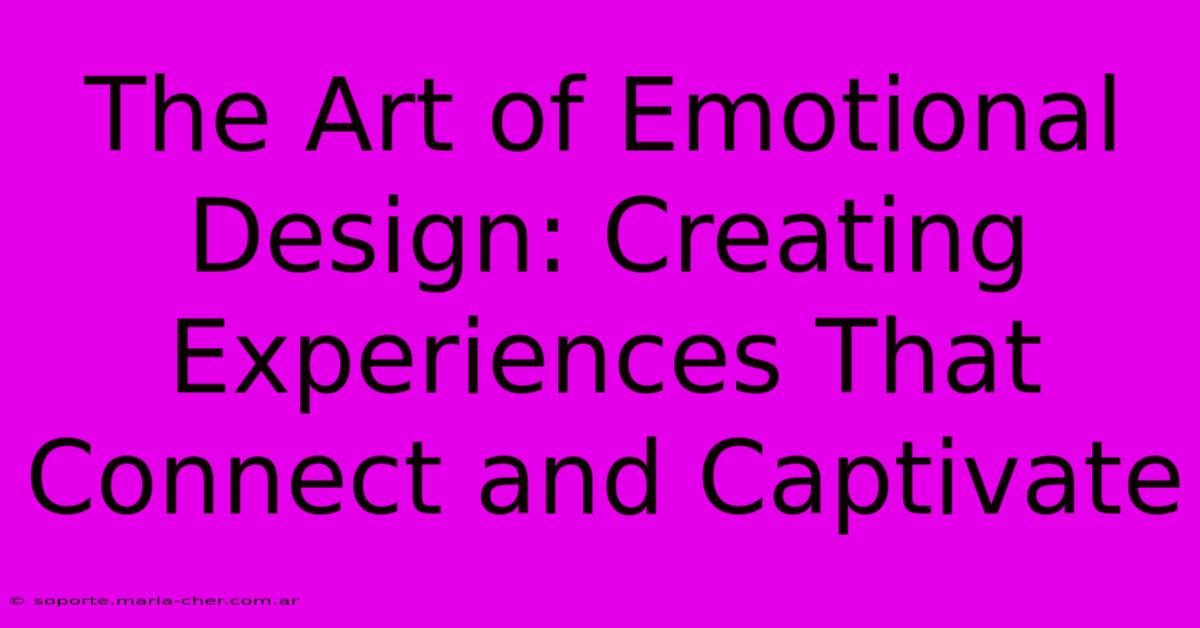The Art Of Emotional Design: Creating Experiences That Connect And Captivate

Table of Contents
The Art of Emotional Design: Creating Experiences That Connect and Captivate
In today's competitive landscape, simply providing a functional product or service isn't enough. Consumers crave experiences – experiences that resonate on an emotional level, forging a deeper connection with your brand and fostering lasting loyalty. This is where the art of emotional design comes into play. It's about understanding the psychology behind human emotions and leveraging that knowledge to craft engaging and memorable interactions.
Understanding the Power of Emotion in Design
Emotional design isn't about slapping a cute graphic on your website or adding a whimsical jingle to your advertisement. It's a strategic approach that considers the entire user journey, anticipating their needs and emotions at each touchpoint. Think about your favorite brands – what makes them stand out? It's likely more than just the quality of their product; it's the feeling they evoke.
The Three Levels of Emotional Design:
Emotional design expert Don Norman outlines three levels:
-
Visceral Design: This is the immediate, gut-level reaction to a product or experience. It's about aesthetics, initial impressions, and sensory appeal. Does it look good? Does it feel good in your hand? Does it sound pleasing?
-
Behavioral Design: This focuses on the usability and functionality of the design. Is it easy to use? Does it solve a problem effectively? Does it provide a satisfying experience?
-
Reflective Design: This is the long-term impact of the design. Does it evoke positive memories and associations? Does it create a sense of pride or accomplishment? Does it enhance the user's self-image?
By carefully considering all three levels, designers can create products and experiences that resonate deeply with users.
Key Principles of Emotional Design:
Several key principles underpin successful emotional design:
-
Empathy: Put yourself in the user's shoes. Understand their needs, frustrations, and motivations. Conduct thorough user research to gain valuable insights.
-
Storytelling: Weave a narrative into your design. Use visuals, language, and interactive elements to tell a compelling story that connects with your audience on an emotional level.
-
Surprise and Delight: Incorporate unexpected elements that create moments of joy and wonder. These unexpected positive experiences create strong positive associations.
-
Consistency and Trust: Maintain a consistent brand voice and visual identity throughout the user experience. This builds trust and reinforces your brand's personality.
-
Personalization: Tailor the experience to the individual user whenever possible. This shows that you care and value their business.
Applying Emotional Design in Different Contexts:
The principles of emotional design can be applied across various industries and contexts:
-
Website Design: Use compelling visuals, intuitive navigation, and personalized content to create a positive and engaging online experience.
-
App Development: Focus on intuitive interfaces, smooth functionality, and delightful micro-interactions.
-
Product Design: Consider the ergonomics, aesthetics, and overall sensory experience of the product.
-
Marketing and Advertising: Use emotionally resonant imagery, storytelling, and calls to action to connect with your target audience.
Measuring the Success of Emotional Design:
While quantifying emotional responses can be challenging, there are several metrics you can track:
-
User engagement: Track metrics such as time spent on site, bounce rate, and conversion rates.
-
Customer satisfaction: Conduct surveys and gather feedback to understand users' emotional responses to your product or experience.
-
Brand loyalty: Measure repeat purchases, customer retention rates, and brand advocacy.
Conclusion:
The art of emotional design is a powerful tool for creating experiences that connect with users on a deeper level. By understanding the psychology behind human emotions and applying the principles outlined above, you can design products and services that not only meet functional needs but also evoke positive emotions, fostering brand loyalty and driving business success. Investing in emotional design is an investment in building lasting relationships with your customers.

Thank you for visiting our website wich cover about The Art Of Emotional Design: Creating Experiences That Connect And Captivate. We hope the information provided has been useful to you. Feel free to contact us if you have any questions or need further assistance. See you next time and dont miss to bookmark.
Featured Posts
-
Paint Your Wedding Day With Hot Pink A Bouquet That Steals The Spotlight
Feb 08, 2025
-
The Psychology Of Color How Hues Influence Moods Behaviors And Decisions
Feb 08, 2025
-
Transform Your Events Into Fairy Tales With Bulk Rose Petals
Feb 08, 2025
-
Size Matters Whats The Optimal Polaroid Dimension For Every Occasion
Feb 08, 2025
-
Babys Breath Heaven Get Your Dreamy Floral Fix Here
Feb 08, 2025
